Lipid Clinic
Since 2005, the Lipid Clinic at CHOC has been caring for children who are at risk for developing heart disease because of genetic or acquired dyslipidemias. Using a multidisciplinary approach that includes an exercise educator, dietitian and cardiologist, we work with more than 150 patients each year to provide ongoing medical monitoring every three to six months, as well exercise and lifestyle recommendations with expert meal planning based on each patient’s specific lipid imbalances and, in some cases, drug therapy when indicated. The Lipid Clinic is the only multidisciplinary clinic in the region that is dedicated to the treatment of lipid imbalances in children.

Understanding Dyslipidemia
If a child has dyslipidemia, he or she has abnormal lipid levels. Lipids are the fats found in blood. People with dyslipidemia have lipid levels that are either too high or two low. Dyslipidemia in children and teens can be caused by a variety of factors, including family history and lifestyle choices.
Approximately one-third (37%) of American children have dyslipidemia. If this condition goes untreated, children could go on to develop heart disease as adults. It is important to know the facts about fats. Learn more about cholesterol, LDL, HDL and triglycerides in children and adolescents.
A referral to the Lipid Clinic comes after a pediatrician has monitored the lipid levels of a patient over a period of time. If the dyslipidemia does not improve or becomes worse, he or she may then refer the patient to the Lipid Clinic. Before treating the dyslipidemia, Lipid Clinic staff work to evaluate the cause of the imbalance. By reviewing each patient’s personal and family medical history and current lifestyle, they will try to determine whether the lipid imbalance is caused by genetics (family history) or lifestyle. Children who have a lipid condition that appears to not be caused by lifestyle choices will be seen in the clinic at the earliest available appointment. Those who are on medication will remain Lipid Clinic patients indefinitely and will receive ongoing monitoring for their condition, which can include tests like echocardiograms and blood tests. Children and adolescents who are appear to have dyslipidemia due to their lifestyle, which can include poor diet and lack of exercise, may be referred to lifestyle classes for six months in order to see if increasing physical activity and changing the child’s diet improves the dyslipidemia. If the child’s lipid levels do not improve with the lifestyle changes, they may then be seen by the Lipid Clinic. Children who improve with diet and exercise changes will continue to be monitored by their pediatrician.
Healthy Lifestyles for Healthy Hearts

Sometimes lipid concerns can be taken care of by improving a child’s nutrition and physical activity habits. If a child is overweight or obese, has high cholesterol or has a high body mass index (BMI), they may be referred to one of CHOC healthy lifestyle programs prior to visiting the Lipid Clinic. Our programs offer interactive activities for the entire family to make changes to their health.
Facts About Cholesterol, LDL, HDL and Triglycerides in Children and Adolescents
Cholesterol and other fats are transported through the blood stream in the form of round particles called lipoproteins. The two most commonly known lipoproteins are low-density lipoproteins (LDL) and high-density lipoproteins (HDL).
A lipid screening consists of a blood test that provides a child’s health care team with an overall look at the fats in the blood. In the past, doctors felt that children and adolescents were at little risk for developing high cholesterol levels and other risk factors for heart disease until later in life. However, we now know that children and adolescents are at risk for having high blood cholesterol levels as a result of one or more of the following:
- Sedentary lifestyles (playing video games, watching TV, not participating in vigorous exercise)
- High-fat or high-sugar "junk food" diets
- Obesity
- Family history of high cholesterol levels.
A full lipid profile shows the actual levels of each type of fat in the blood, such as LDL, HDL, triglycerides and total cholesterol. The child's doctor will compare the child’s results with normal values after considering the child’s age and the number of risk factors present.
Children and adolescents with high cholesterol are at higher risk for developing heart disease as adults. Keeping blood cholesterol levels in the normal range throughout one's lifetime reduces the likelihood of developing heart and blood vessel diseases, such as coronary artery disease (blockages in the arteries that supply blood to your heart) and high blood pressure.
This type of cholesterol is commonly called "bad" cholesterol. It can contribute to the formation of plaque build-up in the arteries, known as atherosclerosis. People commonly refer to atherosclerosis as "blockages in my heart."
LDL levels should be low. To help lower LDL levels, children and adolescents should:
- Avoid foods high in saturated and trans fat, dietary cholesterol and excess calories in general
- Increase exercise
- Maintain a healthy weight.
This type of cholesterol is known as "good" cholesterol, and is a type of fat in the blood that helps to remove cholesterol from the blood, preventing the fatty build up and formation of plaque in your blood vessels. HDL should be as high as possible. It is often possible to raise HDL by avoiding saturates in foods and decreasing body weight. Vigorous exercise for 60 minutes each day can also help to increase HDL.
Triglycerides are another class of fat found in the bloodstream. The bulk of an adolescent's body fat tissue is in the form of triglycerides.
The link between triglycerides and heart disease is under clinical investigation. However, many children and adolescents with high triglyceride levels also have other risk factors such as high LDL levels or low HDL levels.
Elevated triglyceride levels may be caused by medical conditions such as diabetes, hypothyroidism, kidney disease or liver disease. Dietary causes of elevated triglyceride levels in children and adolescents may include obesity and high intakes of fat and concentrated sweets. Alcohol can be a factor for teens who drink.
Blood cholesterol is very specific to each person. In general, cholesterol levels are categorized as follows:
|
Low |
Acceptable |
Borderline High |
High |
Total cholesterol |
- |
Less than 170 |
170-199 |
200 or higher |
LDL cholesterol |
- |
Less than 110 |
110-129 |
130 or higher |
Triglycerides for children ages 0-9 |
- |
Less than 75 |
75-99 |
100 or higher |
Triglycerides for children ages 10-19 |
|
Less than 90 |
90-129 |
130 or higher |
HDL cholesterol |
Less than 40 |
Greater than 45 |
40-45 |
- |
* Adapted from PEDIATRICS Volume 128, Supplement 6, December 2011
If the results of a child's lipid tests are abnormal, the child's doctor will work closely with the child and his or her family to devise a treatment plan based on the factors most likely causing the child’s high cholesterol. Most children and adolescents will not need prescription medication. Often, a healthy diet, weight loss and increased physical activity are enough to return blood lipid levels to normal.
In some cases, the child may be referred to a cardiologist or to a specialty program like the Lipid Clinic at CHOC Children’s.
Knowledge is the Best Medicine
High Blood Pressure in Kids
High blood pressure can affect people of all ages – kids included. High blood pressure in children can result in serious, long-term health problems and can cause a stroke.
Understanding Childhood Obesity
Exercise helps keep kids fit and should be a part of every child’s daily routine. Read on for tips to make exercise a lifestyle habit for kids that starts in infancy.
Kids and Healthy Eating Habits
Offer children a variety of foods so they can try things and develop healthy eating habits: fresh fruit and vegetables are best and limit sweetened foods.















